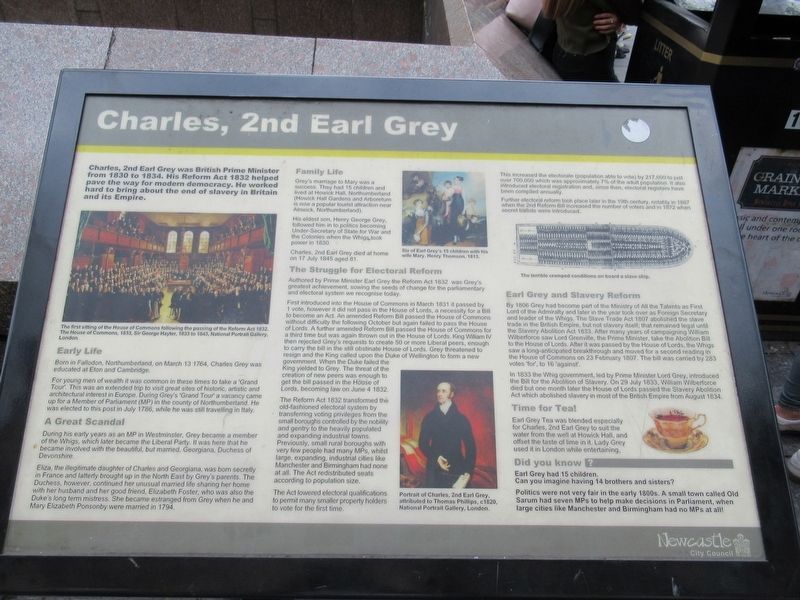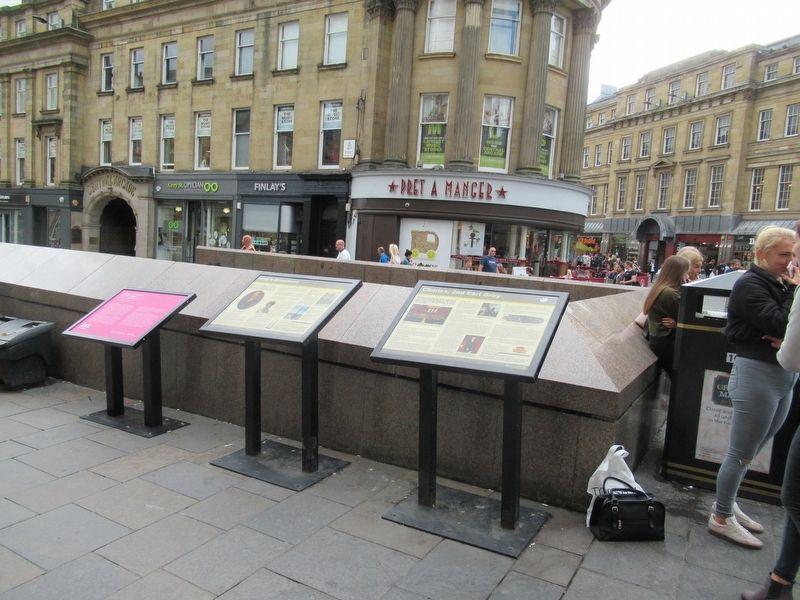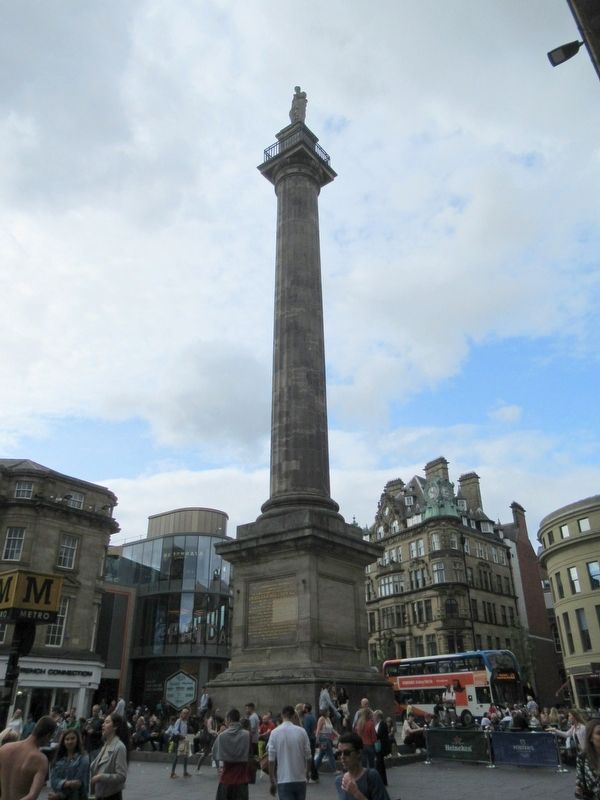Newcastle upon Tyne in Tyne and Wear, England, United Kingdom — Northwestern Europe (the British Isles)
Charles, 2nd Earl Grey
Charles, 2nd Earl Grey was British Prime Minister from 1830 to 1834. His Reform Act 1832 helped pave the way for modern democracy. He worked hard to bring about the end of slavery in Britain and its Empire.
Early Life
Born in Fallodon, Northumberland, on March 13 1764, Charles Grey was educated at Eton and Cambridge. For young men of wealth it was common in these times to take a ‘Grand Tour’. This was an extended trip to visit great sites of historic, artistic and architectural interest in Europe. During Grey's ‘Grand Tour’ a vacancy came up for a Member of Parliament (MP) in the county of Northumberland. He was elected to this post in July 1786, while he was still travelling in Italy.
A Great Scandal
During his early years as an MP in Westminster, Grey became a member of the Whigs, which later became the Liberal Party. It was here that he became involved with the beautiful, but married, Georgiana, Duchess of Devonshire.
Eliza, the illegitimate daughter of Charles and Georgiana, was born secretly in France and latterly brought up in the North East by Grey's parents. The Duchess, however, continued her unusual married life sharing her home with her husband and her good friend, Elizabeth Foster, who was also the Duke's long term mistress. She became estranged from Grey when he and Mary Elizabeth Ponsonby were married in 1794.
Family Life
Grey's marriage to Mary was a success. They had 15 children and lived at Howick Hall, Northumberland (Howick Hall Gardens and Arboretum is now a popular tourist attraction near Alnwick, Northumberland). His eldest son, Henry George Grey, followed him in to politics becoming Under-Secretary of State for War and the Colonies when the Whigs took power in 1830. Charles, 2nd Earl Grey died at home on 17 July 1845 aged 81.
The Struggle for Electoral Reform
Authored by Prime Minister Earl Grey the Reform Act 1832 was Grey's greatest achievement, sowing the seeds of change for the parliamentary and electoral system we recognise today.
First introduced into the House of Commons in March 1831 it passed by 1 vote, however it did not pass in the House of Lords, a necessity for a Bill to become an Act. An amended Reform Bill passed the House of Commons without difficulty the following October but again failed to pass the House of Lords. A further amended Reform Bill passed the House of Commons for a third time but was again thrown out in the House of Lords. King William IV then rejected Grey's requests to create 50 or more Liberal peers, enough to carry the bill in the still obstinate House of Lords. Grey threatened to resign and the King called upon the Duke of Wellington to form a new government. When the Duke failed the King yielded to Grey. The threat of the creation of new peers was enough to get the bill passed in the House of Lords, becoming law on June 4 1832.
The Reform Act 1832 transformed the old-fashioned electoral system by transferring voting privileges from the small boroughs controlled by the nobility and gentry to the heavily populated and expanding industrial towns. Previously, small rural boroughs with very few people had many MPs, whilst large, expanding, industrial cities like Manchester and Birmingham had none at all. The Act redistributed seats according to population size. The Act lowered electoral qualifications to permit many smaller property holders to vote for the first time.
This increased the electorate (population able to vote) by 217,000 to just over 700,000 which was approximately 7% of the adult population. It also introduced electoral registration and, since then, electoral registers have been compiled annually.
Further electoral reform took place later in the 19th century, notably in 1867 when the 2nd Reform Bill increased the number of voters and in 1872 when secret ballots were introduced.
Earl Grey and Slavery Reform
By 1806 Grey had become part of the Ministry of All the Talents as First Lord of the Admiralty and later in the year took over as Foreign Secretary and leader of the Whigs. The Slave Trade Act 1807 abolished the slave trade in the British Empire, but not slavery itself; that remained legal until the Slavery Abolition Act 1833. After many years of campaigning William Wilberforce saw Lord Grenville, the Prime Minister, take the Abolition Bill to the House of Lords. After it was passed by the House of Lords, the Whigs saw a long-anticipated breakthrough and moved for a second reading in the House of Commons on 23 February 1807. The bill was carried by 283 votes 'for', to 16 'against'.
In 1833 the Whig government, led by Prime Minister Lord Grey, introduced the Bill for the Abolition of Slavery. On 29 July 1833, William Wilberforce died but one month later the House of Lords passed the Slavery Abolition Act which abolished slavery in most of the British Empire from August 1834.
Time for Tea!
Earl Grey Tea was blended especially for Charles, 2nd Earl Grey to suit the water from the well at Howick Hall, and offset the taste of lime in it. Lady Grey used it in London while entertaining.
Did you know ?
Earl Grey had 15 children. Can you imagine having 14 brothers and sisters?
Politics were not very fair in the early 1800s. A small town called Old Sarum had seven MPs to help make decisions in Parliament, when cities like Manchester and Birmingham had no MPs at all!
( photo captions )
The first sitting of the House of Commons following the passing of the Reform Act 1832. The House of Commons, 1833, Sir George Hayter, 1833 to 1843, National Portrait Gallery, London.
Six of Earl Grey’s 15 children with his wife Mary. Henry Thomson, 1813.
Portrait of Charles, 2nd Earl Grey, attributed to Thomas Phillips, c1820, National Portrait Gattery, London.
The terrible cramped conditions on board a slave ship.
Erected by Newcastle City Council.
Topics. This historical marker is listed in this topic list: Government & Politics. A significant historical date for this entry is February 23, 1807.
Location. 54° 58.422′ N, 1° 36.773′ W. Marker is in Newcastle upon Tyne, England, in Tyne and Wear. Marker is at the intersection of Grey Street and Blackett Street, on the left when traveling north on Grey Street. Touch for map. Marker is in this post office area: Newcastle upon Tyne, England NE1 5AF, United Kingdom. Touch for directions.
Other nearby markers. At least 8 other markers are within walking distance of this marker. Grey’s Monument (here, next to this marker); Charles Earl Grey (a few steps from this marker); Suffragette Movement (about 150 meters away, measured in a direct line); Jose Maria de Eca de Quiros (about 180 meters away); Cathedral Church of St. Nicholas (approx. 0.4 kilometers away); Victoria R I (approx. 0.4 kilometers away); Ever Tower (approx. 0.4 kilometers away); Charles Avison (approx. 0.4 kilometers away). Touch for a list and map of all markers in Newcastle upon Tyne.
Also see . . . Charles Grey, 2nd Earl Grey on Wikipedia. (Submitted on November 22, 2018, by Michael Herrick of Southbury, Connecticut.)
Credits. This page was last revised on January 27, 2022. It was originally submitted on November 22, 2018, by Michael Herrick of Southbury, Connecticut. This page has been viewed 182 times since then and 20 times this year. Photos: 1, 2, 3. submitted on November 22, 2018, by Michael Herrick of Southbury, Connecticut.


